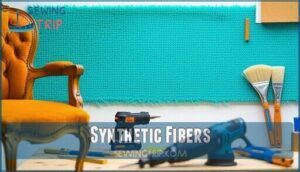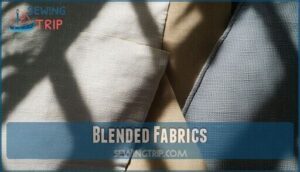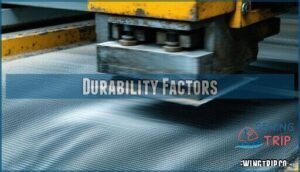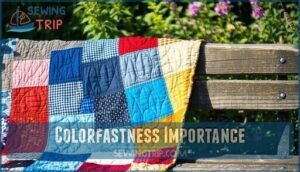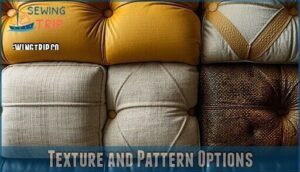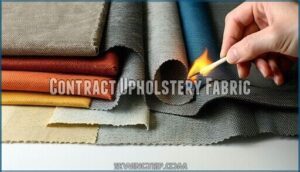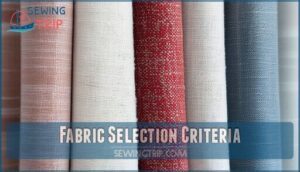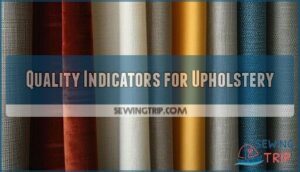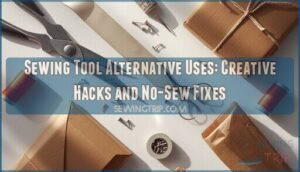This site is supported by our readers. We may earn a commission, at no cost to you, if you purchase through links.
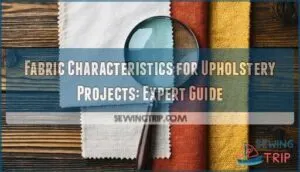
The fabric’s weight, weave construction, and fiber content directly impact performance – synthetic fibers like polyester offer superior stain resistance while natural fibers provide breathability.
Check colorfastness ratings to prevent fading, verify proper stretch recovery to avoid sagging, and verify flame retardancy compliance for safety.
Contract-grade fabrics deliver enhanced durability through tighter weaves and protective treatments, making them ideal for high-traffic furniture pieces that face daily wear from family life, ensuring superior stain resistance.
Table Of Contents
Key Takeaways
- Prioritize durability ratings above 15,000 double-rubs for residential upholstery and higher for commercial use to ensure your furniture withstands daily wear and maintains its appearance over time.
- Choose synthetic fibers like polyester for superior stain resistance while selecting natural fibers when you need breathability – each fiber type offers distinct performance advantages for different upholstery applications.
- Verify colorfastness ratings and flame retardancy compliance before purchasing to prevent fading from UV exposure and ensure your upholstery meets safety standards for your specific environment.
- Consider contract-grade fabrics with tighter weaves for high-traffic furniture pieces since they deliver enhanced durability through protective treatments and superior construction methods.
Fabric Types Overview
You’ll encounter three main fabric categories when selecting upholstery materials: natural fibers, synthetic fibers, and blended fabrics.
Each type offers distinct advantages for durability, comfort, and maintenance in your furniture projects.
Natural Fibers
Natural fibers bring time-tested performance to your upholstery projects.
Cotton durability makes it perfect for high-traffic pieces, while linen texture adds sophisticated appeal.
Silk sheen creates luxury statements, and wool warmth provides cozy comfort.
These natural upholstery fibers offer reliable fiber sourcing and proven longevity.
Natural fabrics deliver authentic character that synthetic materials can’t match.
For breathability and softness, consider cotton fabric options.
Synthetic Fibers
Synthetic fibers offer superior performance characteristics compared to their natural counterparts.
These man-made materials resist common upholstery challenges while maintaining aesthetic appeal.
- Polyester Properties – Excellent wrinkle resistance and color retention
- Acrylic Advantages – Wool-like texture with enhanced durability
- Nylon Uses – High tensile strength for heavy-traffic areas
- Olefin Benefits – Outstanding stain resistance and quick drying
- Microfiber Durability – Ultra-fine construction prevents fabric deterioration
Blended Fabrics
With blended fabrics, you’re getting the best of both worlds – combining natural and synthetic fibers creates superior upholstery fabric durability while maintaining cost effectiveness.
These weave combinations deliver enhanced fabric abrasion resistance and stain resistant upholstery properties.
Fiber synergy means cotton’s breathability pairs with polyester’s strength, though care complexity increases with mixed requirements.
Upholstery Fabric Characteristics
When you’re selecting upholstery fabric, durability becomes your top priority since furniture endures daily wear and tear.
The fabric’s colorfastness, texture, and pattern choices will determine both your project’s longevity and visual appeal.
Durability Factors
When selecting upholstery fabric, you’ll need to evaluate several key durability factors that determine longevity.
Abrasion resistance measures how well fabric withstands friction from daily use. Tear strength indicates resistance to rips, while seam slippage affects structural integrity.
Fiber strength directly impacts fabric performance over time, making these characteristics essential for long-lasting upholstery.
Consider also that olefin resists mildew and performs well in high-traffic areas, with abrasion resistance and tear strength being crucial for its overall longevity.
Colorfastness Importance
Your upholstery’s fabric colorfastness determines how well colors withstand daily challenges like UV degradation from sunlight and wash resistance during cleaning.
Poor dye stability leads to fading, while high crocking potential means colors transfer onto clothing.
Light exposure gradually breaks down pigments, so you’ll want fade resistant fabric with proven fabric performance.
Quality upholstery fabric durability depends on testing these fabric characteristics before purchase.
Texture and Pattern Options
Through texture and tactile appeal, you’ll discover endless design possibilities for your upholstery projects.
Fabric feel ranges from smooth leather-like surfaces to plush velvets with embossed details. Visual complexity varies dramatically – small-scale patterns create subtle sophistication while bold designs make striking statements.
Pattern scale affects room perception, with larger motifs expanding spaces. Consider fabric texture alongside pattern coordination to achieve balanced, inviting interiors that reflect your personal style preferences.
Shoppers can find a wide variety of upholstery fabric textures online, which can help in selecting the right fabric texture for their projects, ultimately leading to inviting interiors.
Contract Upholstery Fabric
When you’re selecting contract upholstery fabric, you’re dealing with materials specifically engineered for commercial environments that demand superior performance standards.
These heavy-duty fabrics must meet strict requirements for flame resistance, stain protection, and durability to withstand constant use in offices, hotels, and public spaces.
Commercial Grade Materials
Commercial fabrics require rigorous testing to meet industry standards.
Quality upholstery demands materials that pass extensive performance tests under real-world conditions.
You’ll find these materials undergo extensive abrasion resistance testing, measuring up to 100,000 cycles. Heavy duty construction prevents seam slippage in high traffic environments.
- Industrial fabrics withstand constant use in offices and hotels
- High performance fabrics resist fading and wear patterns
- Synthetic upholstery fibers offer superior fabric weight for upholstery applications
- Upholstery fabric cleaning becomes simpler with stain-resistant treatments
Flame Retardancy Requirements
You’ll encounter strict testing standards when choosing fire resistant fabric for commercial upholstery projects.
NFPA 260 and TB 117-2013 require fabrics to resist cigarette ignition without excessive charring. Natural resistance comes from wool and certain synthetics, while chemical treatments enhance polyester options.
Regulatory compliance demands proper fabric certifications and consumer safety labels for upholstery fabrics meeting fabric standards through rigorous fabric testing protocols. These standards often involve combustion flame resistance testing to ensure consumer safety and flame retardant properties are met, which is crucial for commercial upholstery projects.
Stain Resistance Features
Protecting your investment starts with choosing fabrics featuring advanced fabric coatings that create molecular barriers against spills.
Modern upholstery fabrics offer exceptional liquid repellency through solution-dyed fibers and specialized fabric finishes that prevent stains from penetrating.
These pet friendly upholstery fabric options resist common household accidents while maintaining fabric durability.
Simple cleaning methods like blotting remove most spills, ensuring your fiber protection lasts for years without compromising stain resistance.
Some materials, like microfiber, have a tightly woven structure that further enhances stain resistance.
Fabric Selection Criteria
When choosing upholstery fabric, you’ll need to evaluate three critical performance factors that determine long-term satisfaction.
Pilling resistance, shrinkage control, and stretch recovery directly impact your project’s durability and appearance over time.
Pilling Resistance
Fabric durability doesn’t stop at commercial standards.
You’ll want pilling-resistant upholstery fabrics that maintain their smooth appearance.
Natural fibers like cotton and wool are more prone to pilling than synthetic options.
Tight weave construction and higher thread counts prevent fiber loosening.
Avoid fabric softeners during care, as they weaken fibers and increase pilling susceptibility.
For everyday comfort, consider fabrics with natural moisture-wicking properties.
Shrinkage Factors
Shrinkage testing reveals how upholstery fabrics react to moisture and heat during cleaning.
You’ll want to understand fiber content since natural materials like cotton shrink more than synthetics. Pre-shrinking methods help prevent surprises after installation.
- Test fabric samples using your planned washing impact and drying techniques
- Check fabric care instructions for manufacturer-recommended cleaning methods
- Verify fabric colorfastness alongside shrinkage to confirm fabric abrasion resistance remains intact
Stretch and Recovery
Beyond preventing shrinkage, you’ll need fabrics that flex without losing their shape.
Fabric elasticity determines how well upholstery conforms to curves, while recovery rate affects long-term appearance.
Poor shape retention leads to upholstery sag over time.
| Fabric Type | Stretch % | Recovery Rate |
|---|---|---|
| Cotton | 0-5% | Poor |
| Polyester Blend | 15-25% | Good |
| Spandex Mix | 40-75% | Excellent |
| Vinyl | 10-20% | Fair |
| Microfiber | 20-30% | Very Good |
Weave influence substantially impacts fabric drape and resilience. Choose upholstery fabrics with moderate fabric stretch for best results, considering fabric elasticity and recovery rate to achieve optimal performance.
Quality Indicators for Upholstery
When selecting upholstery fabric, you’ll need to evaluate specific quality markers that determine long-term performance and appearance.
These indicators help you identify fabrics that can withstand daily use while maintaining their beauty and structural integrity.
Thread Count and Density
When choosing upholstery fabrics, you’ll find thread count and density directly impact performance and longevity.
Higher thread counts typically indicate superior fabric quality, while density affects how well your material handles daily wear.
- Optimal Count: Look for thread counts between 200-400 for balanced durability and comfort
- Density Effects: Tighter weaves resist pilling and maintain shape longer than loose constructions
- Weave Impact: Dense fabrics provide better stain resistance and easier cleaning
- Durability Correlation: Higher density materials withstand furniture stress points more effectively
- Upholstery Grades: Commercial-grade fabrics feature enhanced density specifications for heavy-use applications
Thread count measures threads per square inch, while density refers to how tightly those threads are packed together.
These fabric characteristics determine material properties like strength and appearance retention.
Understanding these upholstery fabric specifications helps you select appropriate fabric quality for your specific project needs.
Weave and Construction
You’ll find that woven fabric durability depends heavily on how fibers interlock during construction.
Fabric layers in plain, twill, and satin weave types create different strength patterns, with tighter interlocking fibers boosting abrasion resistance.
Construction methods like high-density weaving maintain pattern integrity under stress, while loose weaves may separate over time, affecting your upholstery’s longevity.
Understanding factors affecting lifespan is essential for selecting appropriate materials.
Finish and Treatment Options
Protective finishes turn ordinary upholstery into high-performance champions.
Stain protection and water resistance shield against spills, while antimicrobial finishes combat bacteria and odors.
Fire retardancy meets safety codes, and fade resistant fabric maintains vibrant colors.
Wrinkle resistance keeps surfaces smooth.
These treatments enhance fabric durability, simplify fabric care, and reduce fabric maintenance requirements substantially.
Consider exploring options for upholstery with stain protection for enhanced longevity.
Frequently Asked Questions (FAQs)
What are the characteristics of upholstery materials?
You’ll need materials that balance durability with comfort for long-lasting furniture.
Choose tightly woven fabrics like canvas, denim, or synthetic blends that resist wear, stains, and fading while providing adequate cushioning support.
What kind of fabric is best for upholstery?
Don’t worry about durability—proper fabric selection matters more than you think.
Choose tightly woven cotton, linen, or synthetic blends with high thread counts for lasting upholstery that resists wear and maintains appearance.
What characteristics indicate quality in an upholstered piece of furniture?
Look for tight, even stitching without loose threads.
Look for sturdy hardwood frames that don’t wobble.
Look for high-quality foam that springs back when pressed.
Look for durable upholstery fabric that won’t easily snag or fade with use. Sturdy hardwood frames
What are the characteristics of contract upholstery fabric?
You’ll want contract upholstery fabric that’s durable, stain-resistant, and easy to clean.
It should pass heavy-duty abrasion tests, resist fading, and meet fire safety standards.
This fabric handles high traffic, keeping furniture looking sharp longer, which is a key factor in maintaining its appearance.
How do cleaning codes affect fabric maintenance requirements?
A stitch in time saves nine – understanding cleaning codes prevents fabric disasters.
You’ll find W (water-safe), S (solvent-only), WS (either method), or X (vacuum-only) codes that dictate maintenance methods, protecting your investment.
What humidity levels damage upholstery fabrics most?
High humidity levels above 60% damage upholstery fabrics most by promoting mold, mildew, and bacterial growth.
You’ll see fabric deterioration, color fading, and unpleasant odors when moisture gets trapped in fibers consistently, leading to issues like bacterial growth.
Can pet hair penetrate tightly woven fabrics?
Pet hair can definitely penetrate tightly woven fabrics, though it won’t burrow as deeply as in loose weaves.
You’ll find strands working their way between fibers, especially with friction from daily use and movement.
Do leather conditioners work on faux leather?
Though some believe otherwise, leather conditioners work on faux leather and help maintain clean, fresh surfaces while keeping synthetic materials flexible. They reduce mechanical damage and prevent cracking.
Which fabrics show wear patterns fastest?
Cotton blends and lightweight synthetics reveal wear patterns quickest.
You’ll notice fading, pilling, and thread pulls within months on high-traffic furniture.
Natural fibers like linen show fewer signs initially but develop their own character marks over time.
Conclusion
Like choosing the right foundation for a house, selecting proper fabric characteristics for upholstery projects determines whether your furniture will stand the test of time or crumble under daily use.
You’ve learned that durability ratings, fiber content, and construction quality form the backbone of smart fabric selection.
Remember to prioritize double-rub ratings above 15,000, verify colorfastness standards, and match fabric weight to your project’s intended use.
Contract-grade options deliver superior performance for high-traffic areas, while natural fibers excel in breathability applications.
- https://www.pennymorrison.com/journal/how-to-choose-upholstery-fabrics
- https://yorkshirefabricshop.com/blogs/knowledge/what-are-the-most-durable-fabrics-for-upholstered-furniture
- https://www.decorativefabricsdirect.com/Upholstery-Fabric-For-Home-Decor-s/737.htm
- https://granitegold.com/blogs/blog/6-of-the-best-stain-resistant-fabrics-for-sofas
- https://revolutionfabrics.com/collections/upholstery-fabric


